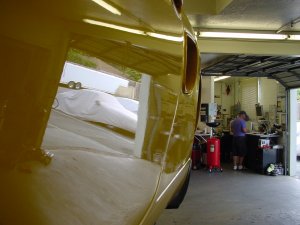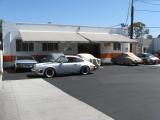
A must for any used Porsche purchase is a "Pre purchase Inspection".
This is so much more value than the POST purchase inspection. First, the inspection should be performed by a qualified shop or individual that knows the model of the Porsche. That person is NOT the salesperson on the lot.
To find a qualified shop or person can take some sleuthing. If the car is local the shop that has been servicing the car COULD be a good place to start. A phone call to the shop asking if they are complete and thorough with the inspection and will give an analysis of the car with utmost candor would be a good place to start. Asking local Porsche owners and going to specific local groups on the internet is another method. If the car is out of the area calling the local head of the PCA (Porsche Club of America) to get a recommendation of a qualified shop is a great idea.
A bit of advice:
- DO NOT buy a black car at night in the rain.
- DO NOT buy a car from across the country with a salvage title and no Pre purchase inspection.
So, what is a "Pre Purchase Inspection?" That depends. The older the car the more intrusive the check out. Inspecting a two year old Porsche with 8K miles from the original owner with no damage history and still under factory warranty is so much easier than inspecting a 1978 930 Turbo with 130K miles with a "fresh tune up".
In the following sections I will try to break down the steps of a thorough "Pre Purchase Inspection". At the end of each section I will try to discuss the differences between newer (less than 5 years) and older Porsches.
At RMG it starts with a phone call, or e-mail from the prospective buyer. We assume the buyer knows what they want and has researched the type and model they want us to check. We get the car in ASAP to avoid loosing the car purchase by the buyer.
STEPS
- On the phone or by e-mail we ask the perspective buyer to try to obtain all of the service records and bring them with the car. This can be difficult with dealers, they are notorious for not having them or "forgetting" them. We also like to have the car washed to check for paint work. Original paint is worth more, PERIOD.
- If the car is driven to the shop by the owner we ask hardball questions. We want to know damage history, and service history. Evasive answers are easy to spot.
- We bring the car into the shop and do a quick visual. Obvious paint work, body gaps, and general LOOK of the car. If obvious flaws are visible we stop. Then, we either, tell, call, or e-mail the buyer and find out if they want us to continue. (usually, they do not). WE DO NOT CHARGE FOR THIS.
- If the initial visual checks out we then proceed. First, we check all lights, wiper & washer functions, then all electrical & mechanical accessories. We go on to check door locks, window operation, seat releases and switches. We note if the hoods are staying up and how they latch. In the front trunk we look at the battery to check it's condition, along with the charging system. We then look at the spare tire, and tools. On pre '90 Porsches we look at the condition of the fuse panel, due to the problems they cause. We also check to see if all the manuals are present. Owners manual, factory service books, and radio-immobilizer code cards. If the car has some form of targa, or convertible top we operate it. All of the above steps are taken no matter how old the car.
- Next the car is put on the hoist and raised about four feet. This is the best height to look at the paint. Original paint has a slight orange peel. This really shows up under florescent light. Most repairs, even great repairs are flat with little or no orange peel. Also under florescent light, sanding scratches and drips show up. As I said earlier OE paint is the best. But on an earlier Porsche, a nice repaint can add value to the car. Of course a state of the art repaint is at least 15K. Prior accident damage and panel replacement is also checked at this time. It is not uncommon for the front valence, bumper, or hood to have been repainted. Causes are driveways on bumpers and valences, and rocks chips on hoods and mirrors. ALL years of Porsches get this inspection.
- Next, the car is fully raised and a complete chassis inspection is performed. Oil leaks are noted. Exhaust condition, oil lines, water lines, A/C lines, fuel lines and brake lines are all inspected. Also, tire wear is noted. (This is one of my pet peeves, if an owner is selling a car with worn out tires, then they have skimped on other things). Then we inspect wheel bearings, and drive shafts. Shocks are inspected for leaking. Tie rods, ball joints and their boots also inspected. Last part of the chassis inspection is the pan. Many Porsches curb surf so damage can occur. Condition, size, & finish of wheels are checked. All years of Porsches get this inspection.
- Now, on to the engine. All cars not under factory warranty, or have more than 15k miles, should have a compression check. We like compression checks. Some customers ask for leak-down checks, they are good, but I have seen at least five engines with less than 10% leakage, with low compression. (Leak-down is a % of air that the cylinder holds. IE, if you pressurize a cylinder with a 100 lbs of air and it holds 95 lbs, then you have 5% leakage). If we have a low cylinder on compression, we try to find the problem using the Leak down test. We also look at the spark plugs. They too can tell a story. Are they the correct plug for the car and we look to see what deposits are on them. We have seen perfect running engines with good compression have oil caking on the plugs. This usually indicates valve guide issues necessitating a valve job. OUCH. On the water cooled cars pulling the plugs can tell you if the water is getting into the cylinder, which means a new engine must be purchased on boxsters, 996's etc. double OUCH.
- On classic 356, early 911's, and rare porsches the engine, chassis, and transmission numbers are checked to see if they are correct for the car. A 73' 911S with the wrong engine, not uncommon, might be worth 20K less. On a 356 you can check the numbers on the front and rear deck lids to see if they match. Also, if you remove the interior panels on the doors you can check the numbers there. Correct number cars are worth much more. (Number freaks really exist).
- A visual of the engine can really tell you quite a bit. Once there you can observe smashed hoses, non OE filters, belts, ignition wires, and patched oil lines. All these really stick out to the trained eye. These are the things telling you what kind of maintenance the car has received.
- On water cooled cars the cooling system is pressure checked, and the condition of the coolant is checked. We check the tank for cracking, and the cap is also pressure checked.
- Now brakes. Rotor and and brake pad thickness is noted as well as the condition of the brake fluid. Porsches last so long that master cylinders and brake lines get neglected. A twenty year old master cylinder is asking for trouble. Usually they fail when your on a long trip and you get towed to "Billy Bobs" where he "Fixes you up".
- Next is the ROAD TEST. Low speed quality is tested during the trip to the freeway. Shifting up and down is tested. Brake function is checked. Bearing noise from wheel bearing and transmission are looked for. All comfort accessories are checked at this time. We listen for abnormal creaks and groans, or engine noise. Then on the freeway the car is accelerated quickly and power is noted. Also, ON/OFF throttle smoking is noted. Alignment is also evaluated. Oil and water temps are noted along with oil pressure. The suspension is evaluated on off ramps and any suspension noise is noted. Finally, when we return to the shop front oil coolers are checked for operation. We look for smoking oil or coolant smells, and then we listen to the beat of the engine.
- After ALL this the four page evaluation is completed and the bidding begins. A rule of thumb is that issues are split 50-50 between seller and buyer. This process has been awkward when dealing with the seller, but honest people and good quality cars usually go together. GOOD HUNTING!


